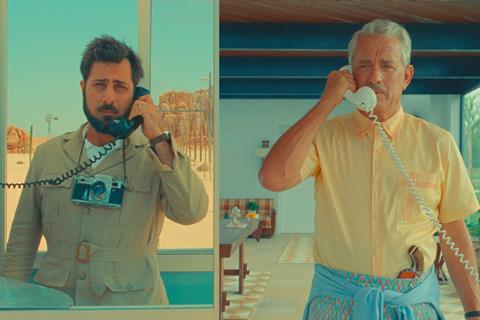Wes Anderson’s star-studded latest revolves around the colourful inhabitants of the titular desert city

Dir: Wes Anderson. US. 2023. 105mins
Wes Anderson’s latest concoction focuses on a group of disparate characters who find themselves stranded in the American desert. This turns out to be, however, a theatre piece being staged far away in New York, and they are all actors. Not since The Grand Budapest Hotel has the writer-director so thoroughly scrutinised the mechanics and limitations of the act of storytelling, constantly reminding us that Asteroid City is nothing but an artifice, even though the problems of the people we meet seem very real. Delightful, occasionally quite moving and always exquisitely crafted, this is a modest charmer about trying to make sense of the world either through art or other pursuits.
At this stage of Anderson’s career, it’s simply a given that Asteroid City will look and sound impeccable
Playing in Competition at Cannes, Anderson’s third film to do so, this likeable yarn opens in the US on June 16 and the UK a week later. There’s a whole galaxy of stars here — alongside the filmmaker’s usual company of actors, Tom Hanks is among the first-timers joining the mix — and Asteroid City’s winning whimsical tone could make this an arthouse hit.
As the story begins, an unnamed narrator (Bryan Cranston), filmed in black and white in a boxy aspect ratio, informs viewers that what we are about to see is a play called ’Asteroid City’ written by the esteemed Conrad Earp (Edward Norton). We are then thrust into that widescreen, brightly coloured tiny desert community, population 87, a town famous for having an asteroid crash land thousands of years ago which left a sizable crater, where a collection of prize-winning young astronomers have gathered with their parents to be honoured.
Among the visitors are Augie (Jason Schwartzman), an emotionally withdrawn war photographer who doesn’t have the heart to tell his brilliant son Woodrow (Jake Ryan) and his three young daughters that their mother has died. But the town’s most notable arrival is Midge (Scarlett Johansson), a glamorous Hollywood actress accompanying her aspiring stargazer daughter Dinah (Grace Edwards).
At this stage of Anderson’s career, it’s simply a given that Asteroid City will look and sound impeccable. Adam Stockhausen’s production design for both the titular desert community and the New York theatre milieu are gorgeous. Shooting in Spain, which gives the American West setting an enchanting surrealness, cinematographer Robert Yeoman ensures that the barren locales are vivid, aided and abetted by some wonderfully understated puppetry and stop-motion animation at the most unexpected times. And although composer Alexandre Desplat may repeat certain sonic techniques from earlier Anderson pictures, his skill at lending the images a delicate melodic undercurrent continues to impress.
Asteroid City introduces us to many peripheral figures — probably too many, including studious teacher June (Maya Hawke), Augie’s critical father-in-law Stanley (Hanks), and Steve Carell as a blandly helpful motel manager. They provide enjoyable background texture to what eventually becomes a story about two blossoming love affairs: one involving the psychically wounded Augie and Midge, and the other involving the innocent, awkward Woodrow and Dinah. But another plotline soon asserts itself once this interstellar-obsessed town is greeted by a quirky extra-terrestrial, sending the community into a panic and prompting the US government to place Asteroid City under quarantine.
Befitting this lighthearted film, the juxtaposition of the primary story in the desert and the behind-the-scenes sequences in New York — in which we see some of the Asteroid City characters as the theatre actors who are bringing those roles to life — isn’t over-intellectualised. And yet, Anderson is interested in how artists work through their anxieties and uncertainties by creating fiction — and how audiences respond to those fictions as if they’re real. This potentially profound idea is handled playfully, but Asteroid City can sometimes be poignant (or wryly amusing) when the two worlds occasionally bleed into one another.
Of the large cast, Schwartzman is immensely amusing as a closed-off photographer who is mourning his wife but can’t articulate his grief, even as he begins to fall for Midge. Johansson brings dimension to her portrayal of what could have been a simplistically tortured movie star. And Hanks acquits himself capably, adapting to Anderson’s stylized, clipped dialogue, although the Oscar-winner feels underused.
But it’s Jake Ryan who steals Asteroid City. Woodrow adores his father but is in danger of becoming as cerebral and sullen, which is why he’s fortunate to meet Dinah. Not since Moonrise Kingdom has Anderson so endearingly detailed the burgeoning romance of two young people, and Ryan and Edwards convey their rush of hormones and insecurity. Many of Asteroid City’s characters look for meaning in the stars above, but Woodrow and Dinah’s courtship suggests sometimes all we need is right in front of us.
Production company: Indian Paintbrush
Worldwide distribution: Universal Pictures
Producers: Wes Anderson, Steven Rales, Jeremy Dawson
Screenplay: Wes Anderson, story by Wes Anderson and Roman Coppola
Cinematography: Robert Yeoman
Production design: Adam Stockhausen
Editing: Barney Pilling
Music: Alexandre Desplat
Main cast: Jason Schwartzman, Scarlett Johansson, Tom Hanks, Jeffrey Wright, Tilda Swinton, Bryan Cranston, Edward Norton, Adrien Brody, Liev Schreiber, Hope Davis, Stephen Park, Rupert Friend, Maya Hawke, Steve Carell, Matt Dillon, Hong Chau, Willem Dafoe, Margot Robbie, Tony Revolori, Jake Ryan, Jeff Goldblum






![The Brightest SunScreen[Courtesy HKIFF]](https://d1nslcd7m2225b.cloudfront.net/Pictures/274x183/3/5/0/1448350_thebrightestsunscreencourtesyhkiff_312678.jpg)















![The Brightest SunScreen[Courtesy HKIFF]](https://d1nslcd7m2225b.cloudfront.net/Pictures/100x67/3/5/0/1448350_thebrightestsunscreencourtesyhkiff_312678.jpg)

